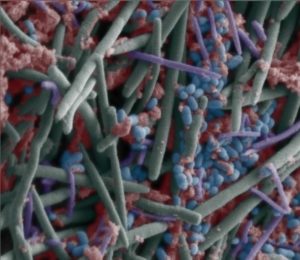Since people have abandoned using iodized salt and started using kosher salt or sea salts, iodine deficiency has increased (especially during pregnancy when iodine needs are greater). The medical journal The Lancet noted in 2008: "According to World Health Organization, in 2007, nearly 2 billion individuals had insufficient iodine intake, a third being of school age. ... Thus iodine deficiency, as the single greatest preventable cause of mental retardation, is an important public-health problem." From Wikipedia : Iodine deficiency is the leading cause of preventable mental retardation, a result which occurs primarily when babies or small children are rendered hypothyroidic by a lack of the element. The addition of iodine to table salt has largely eliminated this problem in the wealthier nations. The article states that iodine deficiency typically lowers IQ by 10 to 15 points. So it's a big deal, a really big deal. But don't overdo the iodine! Excess iodine also has serious problems.From Medscape:
New Recommendations Call for Iodine in All Prenatal Vitamins
Endocrinology groups are applauding a new recommendation from a dietary-supplement trade association that calls for iodine supplementation in all prenatal vitamins prescribed for pregnant and breastfeeding women.
In addition, the public health committee of the American Thyroid Association (ATA) recently published a statement reiterating the ATA recommendation that women take a daily multivitamin containing 150 μg of iodine during prepregnancy, pregnancy, and lactation. The statement also warns of the potential risks of excess iodine consumption and exposure, particularly through the use of unregulated kelp supplements.
The US Council for Responsible Medicine's new guidelines call for all dietary-supplement manufacturers and marketers to begin including at least 150 μg of iodine in all daily multivitamin/mineral supplements intended for pregnant and lactating women in the United States within the next 12 months.
In the past several years, removal of iodized salt from commercial products such as bread and milk, along with increased use of kosher salt and sea salt, which don't contain iodine, and the adoption of vegetarian and vegan diets have led to a reduction in dietary iodine consumption. "There never was a coherent US policy about iodization," Dr Stagnaro-Green noted.
Worldwide, about two billion people are iodine-deficient. While most of the US population has adequate iodine levels, data from the National Health and Nutrition Examination Survey suggest that more than half of pregnant women have urinary iodine concentrations below 150 mg/dL (Thyroid. 2011;21:419-427).
Pregnant women actually need more iodine than other people because of increased thyroid-hormone production, renal losses, and fetal iodine requirements. Iodine deficiency during pregnancy can result in maternal and fetal goiter, cretinism, intellectual impairment, neonatal hypothyroidism, and increased pregnancy loss and mortality, Dr Stagnaro-Green and colleagues explained in a 2012 editorial (JAMA2012;308:2463-2464).
"So, women of childbearing age are the subpopulation of Americans with the lowest iodine levels yet have the greatest need during pregnancy and breastfeeding, for the neurodevelopment of the fetal and neonatal brain," he told Medscape Medical News.
In 2009, a study found that only 51% of US prenatal multivitamin brands contained any iodine and, in a number of randomly selected brands, the actual dose of iodine contained in the supplements did not match values on the labeling.
However, the American College of Obstetricians and Gynecologists (ACOG) has not joined in these efforts. While the group does recommend the 150-μg dose for pregnant and lactating women, it does not currently endorse the prenatal-supplement recommendation, advising instead that women get their iodine through dietary sources.
In the ATA's public health committee statement, Angela M Leung, MD, from the University of California Los Angeles David Geffen School of Medicine, and colleagues, including Dr Stagnaro-Green, note that iodine is a micronutrient required for normal thyroid function. The US recommended daily allowances (RDA) for iodine intake are 150 μg in adults, 220 to 250 μg in pregnant women, and 250 to 290 μg in breastfeeding women. Dietary sources such as iodized salt, dairy products, some breads, and seafood usually contain enough to meet the RDA for most people who aren't pregnant or lactating.
However, there is an upper safety limit, with ingestion of more than 1100 μg/day not recommended due to the risk for thyroid dysfunction. In particular, infants, the elderly, pregnant and lactating women, and people with preexisting thyroid disease are at risk for adverse effects of excess iodine on the thyroid.
Many iodine, potassium iodide, and kelp supplements contain hundredfold greater amounts of iodine than the recommended upper limit, Leung and colleagues caution."Given the increasing popularity of iodine and kelp supplements, recommendations cautioning against excess iodine were indicated. The potential result of iodine-induced thyroid dysfunction, which may be particularly harmful during pregnancy and breastfeeding and in the elderly, may not be well-known," she told Medscape Medical News.
 Gut bacteria in children varies among different Asian countries. A recent study found that microbiota of 303 subjects could be classified into two main clusters: driven by Prevotella (P-type) or by Bifidobacterium/Bacteroides (BB-type).
Gut bacteria in children varies among different Asian countries. A recent study found that microbiota of 303 subjects could be classified into two main clusters: driven by Prevotella (P-type) or by Bifidobacterium/Bacteroides (BB-type).
 A
A  Here is an article to what I referred to in my recent Feb. 27 Feast and Famine Diet post about intermittent fasting being beneficial to health and resulting in weight loss. This definitely seems easier than sticking to very low calorie diets weeks on end. From NPR:
Here is an article to what I referred to in my recent Feb. 27 Feast and Famine Diet post about intermittent fasting being beneficial to health and resulting in weight loss. This definitely seems easier than sticking to very low calorie diets weeks on end. From NPR: Of course some foods are addictive. Anyone who tries to eat just one french fry or one piece of chocolate or one potato chip knows that it's very, very hard to do that. Do people have raw carrot cravings? Nah... Chocolate cravings? Yup..Does this research really tell us anything new? From Science Daily:
Of course some foods are addictive. Anyone who tries to eat just one french fry or one piece of chocolate or one potato chip knows that it's very, very hard to do that. Do people have raw carrot cravings? Nah... Chocolate cravings? Yup..Does this research really tell us anything new? From Science Daily: